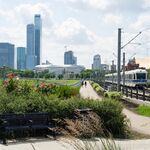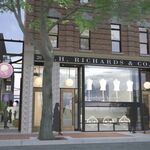archited
Senior Member
So -- in the foregoing two posts we have electric mini-buses and LSM-driven electric rail cars. In both instances we can use solar roofs to augment power to on-board batteries -- batteries that in the case of the rail cars can be remotely recharged at every stop from windings buried 3-inches below grade. Both systems would be remotely controlled from a central monitoring station located somewhere along the avenue in a second-storey office. Avenue sidewalks would be able to expand in width by about 2/3 of a lane-width, creating broad pedestrian paths that could have a large variety of "street furniture" positioned thereon. In the Old West replication I would envision these walkways being composed of larch (tamarack) cross-laminated timber structures -- a wood that would weather to a soft tan patina. Into that surface we could "brand" or burn symbols and fonts that serve many purposes -- directional information; identity information (logos and names), advertising, and planar decoration.
With a cavity below the sidewalk which could dispel warm "stale air" from adjacent buildings we would also achieve a snow-free/ice-free surface here on snowy winter days (less maintenance).
Sidewalk furniture and elements could include a whole array of possibilities -- benches, dining tables, hologram pedestals, statues, retail displays, gaming consoles, awning enclaves, planters -- a veritable wonderland of interest and pedestrian engagement.
With a cavity below the sidewalk which could dispel warm "stale air" from adjacent buildings we would also achieve a snow-free/ice-free surface here on snowy winter days (less maintenance).
Sidewalk furniture and elements could include a whole array of possibilities -- benches, dining tables, hologram pedestals, statues, retail displays, gaming consoles, awning enclaves, planters -- a veritable wonderland of interest and pedestrian engagement.





